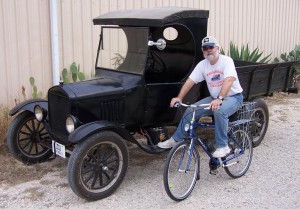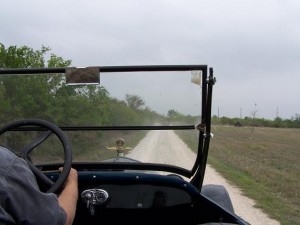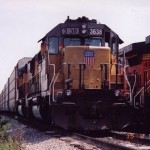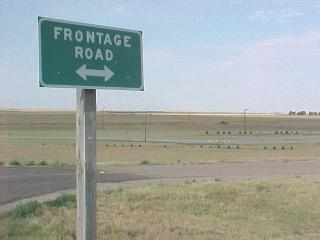Bicycles Commuting History Laws and policies Oil and gas prices Roads Safety Transit
by Hugh
4 comments
My first year as a born again cyclist in San Antonio
 Around four o’clock in the afternoon of Thursday December 31st, zooming alongside the old San Antonio & Aransas Pass railroad tracks on Villamain between Mission San Juan and Mission Espada, in top gear and the wind at my back, I reached my own personal milestone by completing one thousand miles in the first year of owning a bicycle since I left Scotland in 1991. Today, Jnauary 9th, also around 4:00 PM, on De Zavala Road at Clark High school I reached by personal goal of 1,040 miles. That, of course, may seem like an obscure number, so let me explain. more »
Around four o’clock in the afternoon of Thursday December 31st, zooming alongside the old San Antonio & Aransas Pass railroad tracks on Villamain between Mission San Juan and Mission Espada, in top gear and the wind at my back, I reached my own personal milestone by completing one thousand miles in the first year of owning a bicycle since I left Scotland in 1991. Today, Jnauary 9th, also around 4:00 PM, on De Zavala Road at Clark High school I reached by personal goal of 1,040 miles. That, of course, may seem like an obscure number, so let me explain. more »
Commuting History Roads Safety Transit Travel Uncategorized
by Hugh
Comments Off on Book review: Traffic, by Tom Vanderbilt
Book review: Traffic, by Tom Vanderbilt
 I’ve just finished reading “TRAFFIC,” by Tom Vanderbilt, published by Vintage Books in 2009. It is subtitled, “Why we drive the way we do and what it says about us.” I heartily recommend it to anyone interested in trying to understand the mundane yet highly complex activity we call driving.
I’ve just finished reading “TRAFFIC,” by Tom Vanderbilt, published by Vintage Books in 2009. It is subtitled, “Why we drive the way we do and what it says about us.” I heartily recommend it to anyone interested in trying to understand the mundane yet highly complex activity we call driving.
History: economy infrastructure politics ports rivers
by Patrick
Comments Off on “The Geography of Recession”
“The Geography of Recession”
Here’s an interesting take from an Austin intelligence firm on how geography shapes global infrastructure, politics and economies.
Navigable rivers and ports, arable land, borders, weather and other natural features play a big role in how available resources are tied up or freed up, according to Stratfor. Such givens influence how governments and economies organize to meet challenges and also how well they succeed.
Excerpt:
Taken together, the integrated transport network, large tracts of usable land and lack of a need for a standing military have one critical implication: The U.S. government tends to take a hands-off approach to economic management, because geography has not cursed the United States with any endemic problems. This may mean that the United States — and especially its government — comes across as disorganized, but it shifts massive amounts of labor and capital to the private sector, which for the most part allows resources to flow to wherever they will achieve the most efficient and productive results.
Laissez-faire capitalism has its flaws. Inequality and social stress are just two of many less-than-desirable side effects. The side effects most relevant to the current situation are, of course, the speculative bubbles that cause recessions when they pop. But in terms of long-term economic efficiency and growth, a free capital system is unrivaled. For the United States, the end result has proved clear: The United States has exited each decade since post-Civil War Reconstruction more powerful than it was when it entered it. While there are many forces in the modern world that threaten various aspects of U.S. economic standing, there is not one that actually threatens the U.S. base geographic advantages.
Pigs will fly!
As a married man of a certain age, one expects to be given Yuletide tasks. It is a given that your regular round will be interrupted with missions for which it could be said you are not the most adapted member of the family. But it came to pass this holiday season that my dear wife provided me with one of the most extraordinary chores I have ever had to perform at this or any other Christmas. It involves flying pigs at the Mexican border.
History Passenger rail Railroads Uncategorized
by Hugh
Comments Off on Transportation Museum Christmas Show
Transportation Museum Christmas Show
 It’s been a while since I posted here but I’ve been busy setting up “Santa’s railroad Wonderland” at the Texas Transportation Museum. In its eleventh year, this eight night event has become a significant source of revenue for this small, independent museum, which receives no government funding of any kind, from city, county, state and federal levels. So we get by, solely, on visitor support. We must be doing something right because we are still here after 45 years.
It’s been a while since I posted here but I’ve been busy setting up “Santa’s railroad Wonderland” at the Texas Transportation Museum. In its eleventh year, this eight night event has become a significant source of revenue for this small, independent museum, which receives no government funding of any kind, from city, county, state and federal levels. So we get by, solely, on visitor support. We must be doing something right because we are still here after 45 years.
Click http://www.txtransportationmuseum.org/SHD.htm for more information about “Santa’s Railroad Wonderland.”
Commuting History Oil and gas prices Passenger rail Railroads Roads Transit Travel
by Hugh
Comments Off on SA – Austin passenger rail still dead
SA – Austin passenger rail still dead
Like the old Saturday Night sketch about Generalissimo Franco, passenger rail between San Antonio and Austin is still dead. Oh a mortician applied a new coat of make-up, but the poor old stiff ain’t going nowhere. After twelve years of failure, a new name and an application for $5 million of tax payer money was enough to create a blip of interest but even that has not lasted long. Oh well.
Last Ford Model T cruise of 2009
Model Ts at Guadalupe River State Park
I was able, among other pressing projects, to squeeze in one last Model T drive yesterday, Saturday November 14. Accompanied by three other Ts, we drove from the Texas Transportation Museum on Wetmore Road twenty seven miles to the Guadalupe River State Park. Our small convoy represented the gamut of Ts well. There was an open tourer, a closed sedan, a light duty pick-up and the “Diva,” the museum’s heavy duty truck. I began calling it the Diva due to its unfortunate habit of running perfectly well at the museum and local roads but acting up horribly at any public event while, often, being the center of attention, for reasons that both bemuse and confuse me.
A Texas shibboleth
One of the first things that astute visitors and new arrivals to Texas notice is the ubiquity of frontage roads along our freeways. Indeed, Texas has more frontage roads than any other place on the face of the planet. The reason for this phenomenon is because, unlike most other states, Texas frequently upgrades existing roadways to freeways instead of building them on entirely new right-of-way, especially in urban areas. For instance, most of I-35 through Texas was built along what used to be US 81. Because adjacent property owners already had access to the existing highway, the state would either have had to purchase those access rights when the road was upgraded (freeways are controlled-access), which in many cases might actually have resulted in a full-blown taking of the property, or they would have had to devise a way to maintain access to those properties. Texas chose the latter.
Commuting History Passenger rail Railroads Safety Transit Travel
by Hugh
Comments Off on No news = good news for railroads
No news = good news for railroads
 I’m guessing you haven’t heard much about the railroads recently. The more they fly under the radar the better they like it because these days, when it comes to railroads, only bad news is good news. The Union Pacific is probably happy. Sure beats 2004 and the torrent of bad news way back then. These days they are regarded as just one step up from the water and sewage systems. These only make the headlines when something goes wrong. Certainly there are still far too many accidents at grade level road crossings but few blame the railroad for this anymore. If drivers are willing to risk absolutely everything to beat the train, just to save a minute or two and not miss the beginning of “Jeopardy” or something equally banal, well, you cannot legislate away stupidity.
I’m guessing you haven’t heard much about the railroads recently. The more they fly under the radar the better they like it because these days, when it comes to railroads, only bad news is good news. The Union Pacific is probably happy. Sure beats 2004 and the torrent of bad news way back then. These days they are regarded as just one step up from the water and sewage systems. These only make the headlines when something goes wrong. Certainly there are still far too many accidents at grade level road crossings but few blame the railroad for this anymore. If drivers are willing to risk absolutely everything to beat the train, just to save a minute or two and not miss the beginning of “Jeopardy” or something equally banal, well, you cannot legislate away stupidity.
History Roads Travel: classic cars driving old cars restoration
by Hugh
Comments Off on 1929 REO at the Alamo
1929 REO at the Alamo
Some old car restorations take longer than others. In the case of the 1929 REO Flying Cloud coupe belonging to the Texas Transportation Museum, it took a number of volunteers over ten years. But today, just in time for its 80th anniversary, it made its public San Antonio debut at the San Antonio Founder’s Day event held at the Alamo today, Saturday October 24, 2009.
